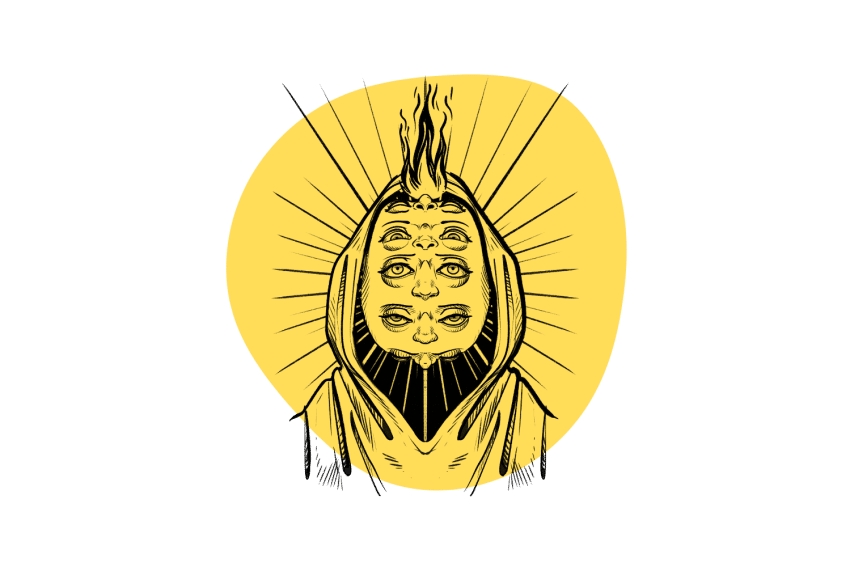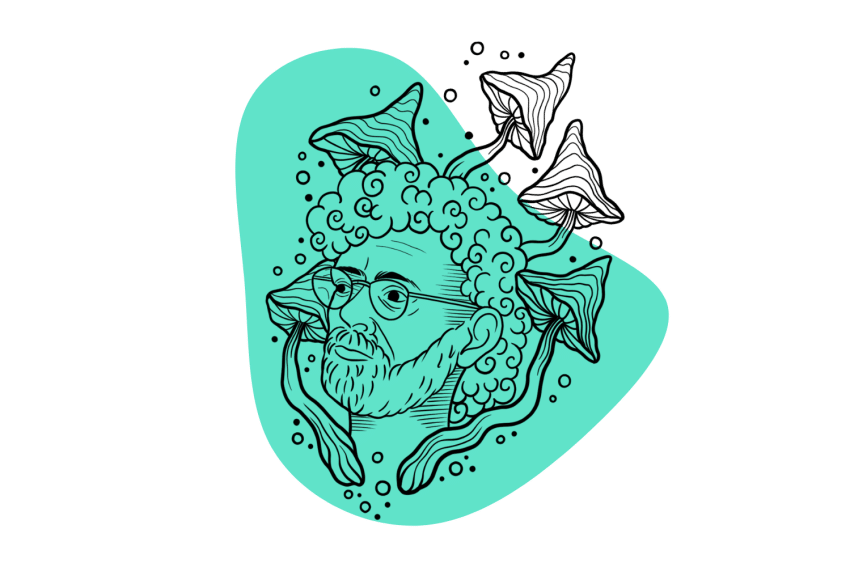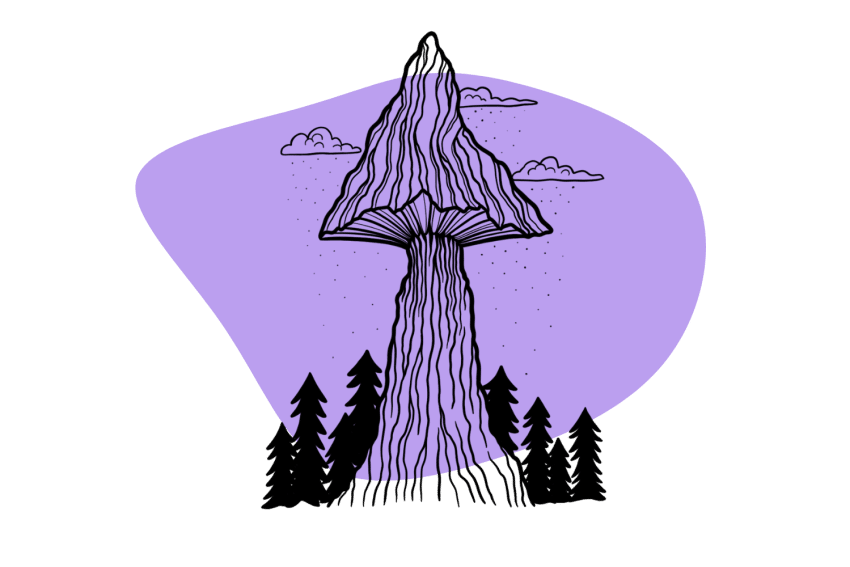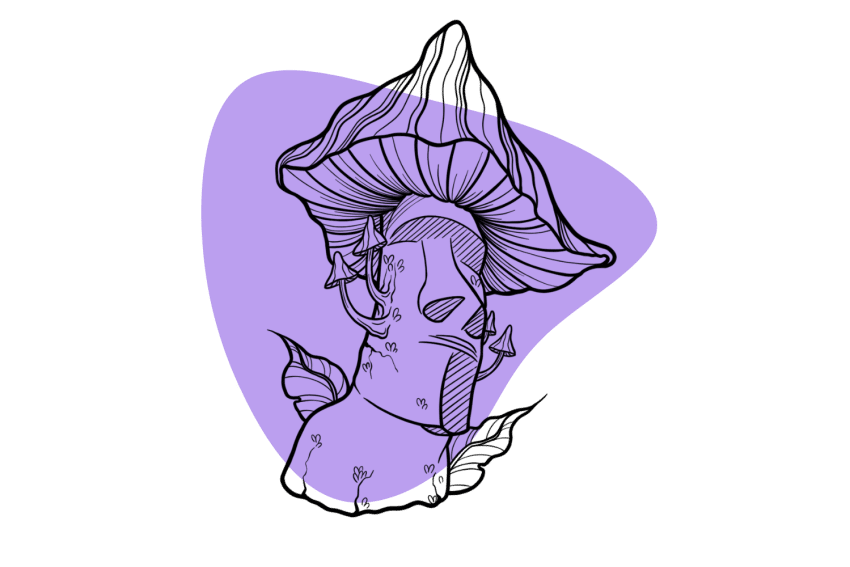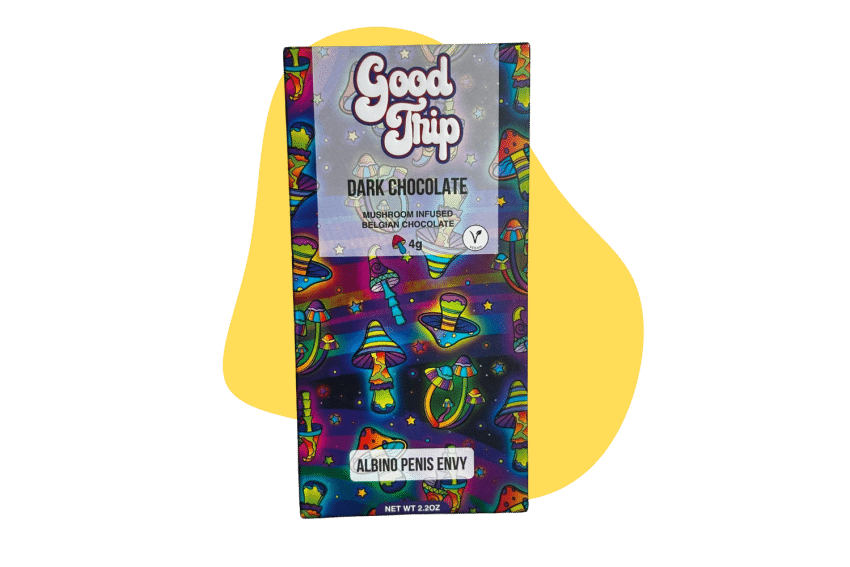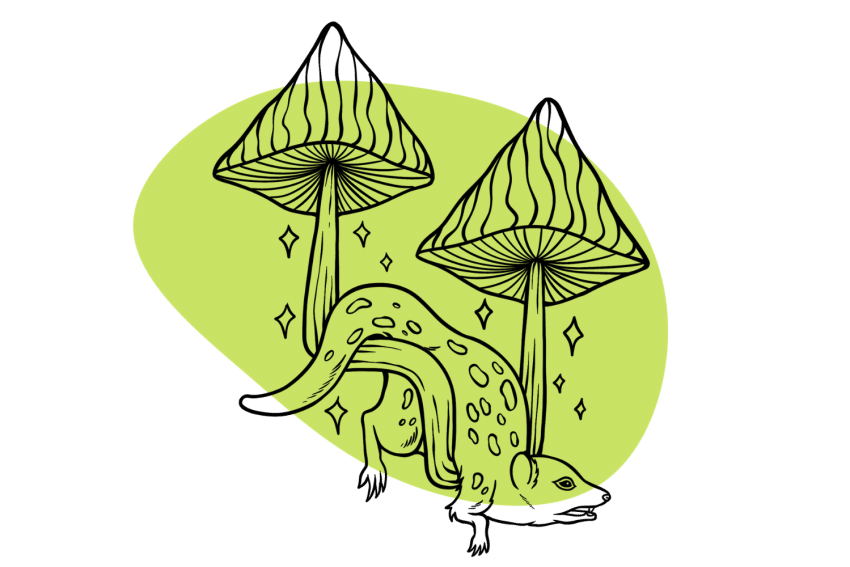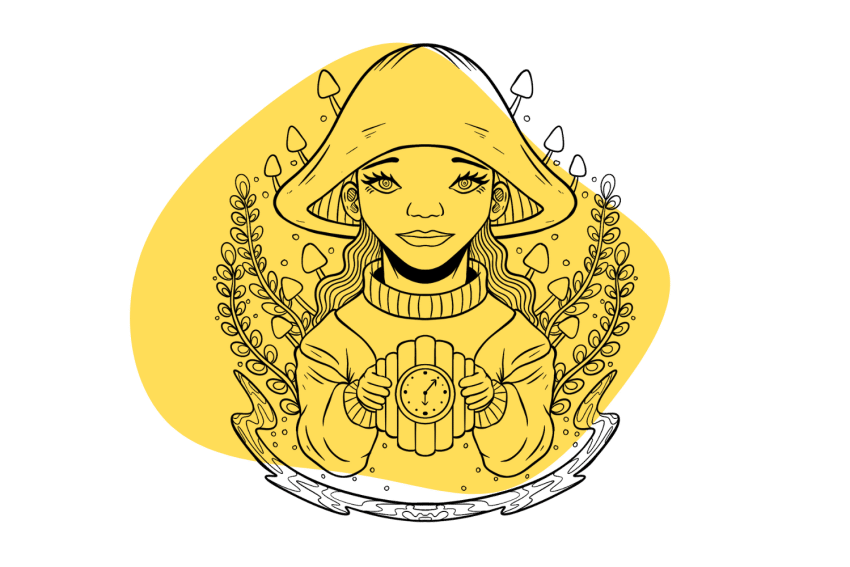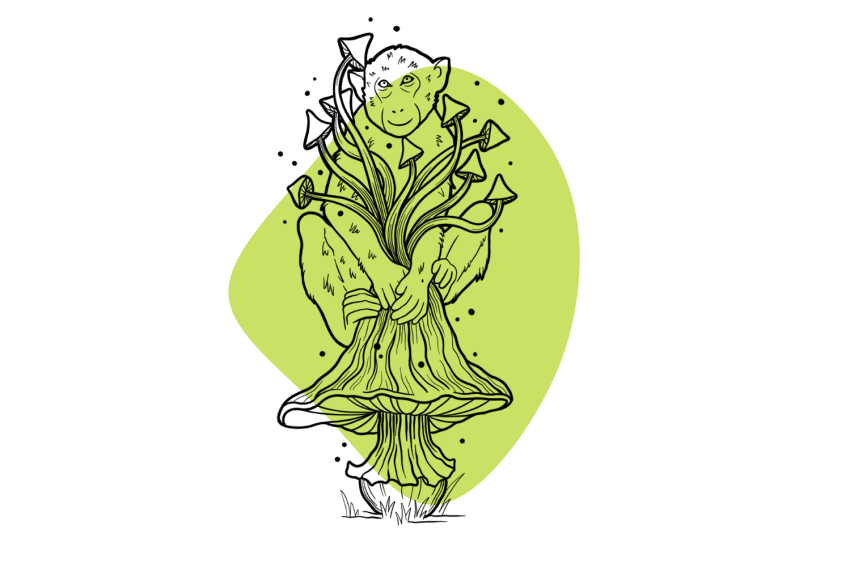Psilocybe caerulescens: The “Derrumbe” (Landslide) Mushroom
Psilocybe caerulescens is a lesser-known species of psilocybin mushroom. However, its wide distribution in the wild and ease of cultivation make it an intriguing species for amateur mycologists.
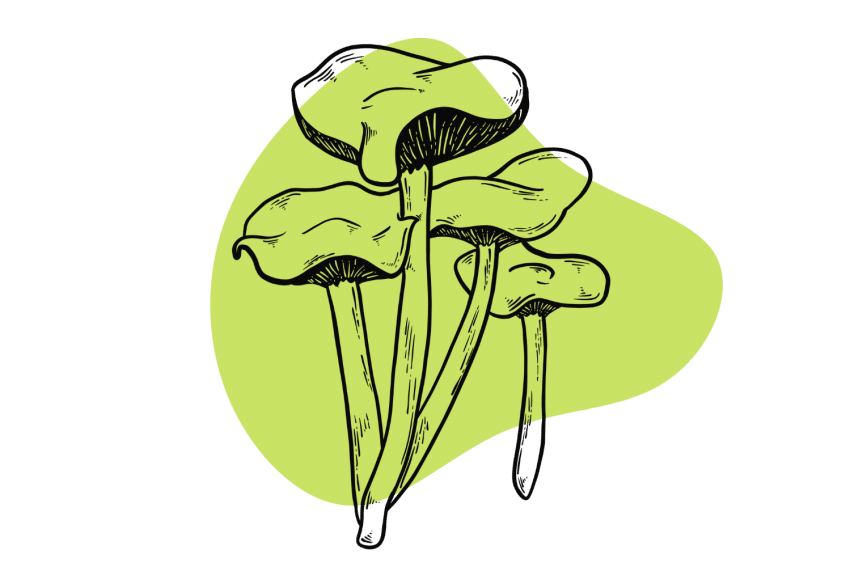
Psilocybe caerulescens — also known as the “Landslide Mushroom” or “Derrumbe” in Spanish — is a psychedelic shroom that produces psilocybin. It’s not a particularly potent magic mushroom species, but it’s capable of producing introspective experiences with moderate visuals.
It gets its common name, “Landslide Mushroom,” from its favorable habitat. They pop up in numbers on disturbed, bare ground. The environment produced by a landslide provides the perfect habitat for this species to grow.
Although P. Caerulescens isn’t as popular as Psilocybe cubensis or as potent as Psilocybe azurescens, it’s an intriguing magic mushroom.
In this article, we’ll explore the history of Psilocybe caerulescens, its potency, effect profile, dosage information (with calculator), why it’s such a good choice for microdosing, identification tips, cultivation, and more.
Related Guides: Magic Mushrooms 101 | How to Grow Magic Mushrooms | Finding Wild Magic Mushrooms
The History of Psilocybe caerulescens
Psilocybe caerulescens isn’t a particularly well-documented species. However, these mushrooms have likely been consumed for millennia — growing in regions of North America where the Mayan and Aztec civilizations once populated.
The famous curandera (medicine woman) Maria Sabina reportedly used this species and others, such as Psilocybe mexicana and Psilocybe cubensis, in her magic mushroom ceremonies. Maria Sabina indirectly introduced the Western world to psilocybin-containing mushrooms through her interaction with Robert Gordan Wasson.
Wasson traveled to meet Maria in her hometown of Huautla de Jiménez in Oaxaca, Mexico. Here, R. Gordon Wasson tripped on Maria Sabina’s shrooms and later released an article in LIFE Magazine titled “Seeking the Magic Mushroom.” This article went viral and ultimately introduced the West to “the magic mushroom.”
The first officially reported Psilocybe caerulescens sample was found near Montgomery, Alabama. William Murrill — a famous American mycologist of the time — discovered the species growing in sugarcane mulch in 1923. The species hasn’t been officially recorded in the area since, but several magic mushroom enthusiasts have reportedly found samples in Alabama.
Unfortunately, that’s as deep as the history of Psilocybe caerulescens gets. The indigenous people of North America have undoubtedly used it for millennia, but paper records from more recent history are more or less non-existent.
There’s much more to find out about this species.
The Potency & Effects of Psilocybe caerulescens
Psilocybe caerulescens shrooms aren’t particularly potent. The typical sample produces an average psilocybin level of around 0.20% — that’s low, even compared to a weak strain of Psilocybe cubensis.
One study that looked into the tryptamine alkaloid levels of several psychotropic mushrooms assessed two samples of Psilocybe caerulescens [1]. One sample produced 0.341 milligrams of psilocin and 0.225 milligrams of psilocybin per gram of dried mushroom. The other sample produced 0.413 milligrams of psilocin and 0.310 milligrams of psilocybin.
Total combined average psilocybin and psilocin level (dry weight percentage): 0.50% to 0.80%.
This study shows us that Psilocybe caerulescens seems to produce more psilocin than psilocybin — this is unusual for magic mushrooms. Psilocin is the active metabolite of psilocybin. When magic mushrooms are consumed, any psilocybin must be converted to psilocin in the liver before it affects the brain.
With higher percentages of psilocin, the user may expect a faster onset of effects. So, although Psilocybe caerulescens mushrooms are weaker than others, the higher levels of psilocin make up for this.
The individual may experience psychedelic effects in as little as 20 minutes after consumption of these mushrooms, with the effects intensifying after an hour or so as the psilocybin is also converted to its active counterpart.
Psilocybe caerulescens is deeply introspective. It‘s capable of producing intense closed-eye visuals and moderate open-eye visuals at standard doses — 2 to 3.5 grams (dry weight). In higher doses — 3.5 to 5 grams (dry weight) — strong visuals, an intense body high, and ego dissolution are likely to occur.
These are the effects you can expect when consuming psilocybin-producing mushrooms:
- Altered perception of time
- Changes in perception of self
- Enhanced creativity
- Euphoria
- Improved mood
- Increased empathy
- Increased introspection
- Increased sociability
- Intense emotions
- Spiritual (mystical) experiences
- Visual & auditory hallucinations
Comparing the Potency of Magic Mushroom Species
We’ve been meticulously tracking the potency data for every mushroom we can get our hands on. Here’s a roundup of the top 20 most potent mushroom species known today.
Psilocybe caerulescens aren’t super potent overall, coming in at a modest 19/20.
Related: Strongest Magic Mushroom Species & Strains | What’s The Average Magic Mushroom Potency?
Psilocybe caerulescens Dosage
Providing an exact weight for a “dose” of Psilocybe caerulescens is difficult. We have limited information on the tryptamine content of this species, so we don’t know how variable the psilocybin and psilocin content can be from one shroom to the next.
Although we’ve rated this species as “low potency,” it may be capable of producing higher tryptamine levels. Many magic mushroom species produce inconsistent levels, meaning one shroom can produce low levels of psilocybin/psilocin, whereas another can produce mind-blowing percentages of the psychedelic alkaloids.
It’s vital to practice caution when consuming any psychedelic mushroom species. Start with a lower dose than you think you need — you can always increase the dose in increments an hour after consumption if the desired effects aren’t reached.
A research paper on psilocybin-producing mushrooms reports a combined psilocin and psilocybin average of 0.50% to 2.00% (a median of 1.25%) across several species of Psilocybe mushrooms [2]. This is higher than the average combined psilocybin and psilocin levels we found during our research into P. caerulescens, which appear to be in the region of 0.50% to 0.80%.
With this data, we can assume that P. caerulescens mushrooms produce roughly the same potency as a weak Psilocybe cubensis strain. This makes it slightly easier to provide a dosage guide.
Here are the rough doses in grams (dry weight) for psilocybe caerulescens:
- Low Dose — 1 gram
- Medium Dose — 1.75 grams
- High Dose — 3.5 grams
- Heroic Dose — 5 grams or more
Magic Mushroom Dosage Calculator
Double-check the potency of the DXM you’re using, and look for the addition of other compounds such as acetaminophen which can cause severe liver-toxic side-effects at this dose.
Microdosing Psilocybe caerulescens
Due to the low levels of psilocybin and relatively high levels of psilocin, Psilocybe caerulescens makes a good candidate for microdosing. They can be found in good numbers in the wild if you live in the right area, and they’re fairly simple to cultivate — making it relatively easy to have a consistent supply.
Having low psychedelic tryptamine levels makes dividing the shrooms into microdoses much easier for the average person without high-tech laboratory equipment.
A microdose is a sub-perceptual dose of a psychoactive substance (a dose low enough that it doesn’t induce any psychoactive effects). In the case of microdosing Psilocybe caerulescens, you’d be microdosing psilocybin.
After consuming a psilocybin microdose, the individual may feel light stimulation and euphoria but no sensory hallucinations of any kind. To achieve a “microdose,” consume roughly one-tenth of a psychoactive dose. This works out to around 50 to 150 milligrams (0.50 to 1.5 grams) of P. caerulescens — roughly equivalent to 3 to 10 mg of combined psilocybin/psilocin.
Microdosing Psilocybe caerulescens or other psilocybin-producing mushrooms can improve mood and increase focus and cognitive performance, as studies suggest [3]. Many people believe that microdosing magic mushrooms can help with ADHD, anxiety, and depression.
If you decide to microdose P. caerulescens, do so in a controlled environment until you know exactly how the dose will affect you. The last thing you want is to take what you think was a “microdose” and turn up at work or a social function tripping.
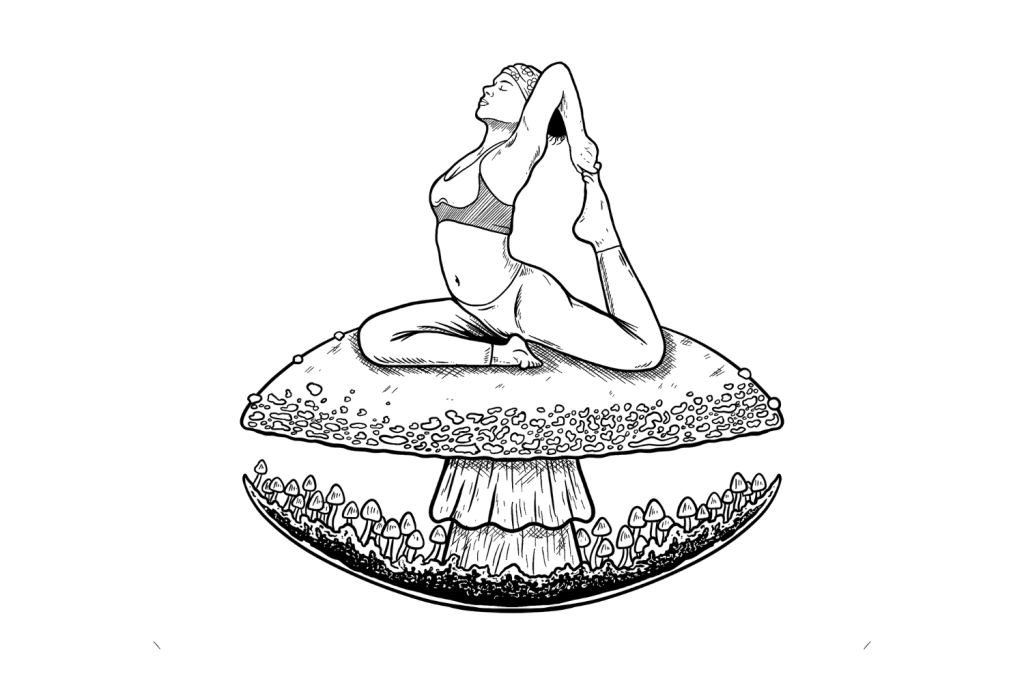
Where Can You Find Psilocybe caerulescens Mushrooms?
Psilocybe caerulescens naturally grows in Mexico and select regions of the Southern United States.
They can be found in numbers in the Oaxaca, Chiapas, and Puebla regions of southern Mexico and are widespread throughout northern Georgia (US). They have also been discovered in Alabama, South Carolina, North Carolina, Louisiana, Mississippi, Texas, and Florida.
Samples have also been found in other parts of the world, like Puerto Rico, Brazil, Colombia, Guatemala, Nicaragua, Panama, Venezuela, Ecuador, and Costa Rica.
Psilocybe caerulescens Habitat
Psilocybe caerulescens can grow in a range of environments, but it particularly likes disturbed ground devoid of plant life. These mushrooms thrive in areas where soil disturbances or landslides have occurred. As a result, they have become associated with such terrain and are commonly referred to as “Landslide Mushrooms.”
These mushrooms grow in tight clusters and prefer muddy, wet environments. They like soils containing wood debris and rotting organic matter and are often found in forested or woody areas. They are commonly associated with subtropical and tropical environments and are usually found at high elevations.
The exact elevation at which Psilocybe caerulescens is found can vary, but the species is often associated with hilly or mountainous areas. They can be found at elevations ranging from lower mountain slopes to higher mountain regions but will also grow in lowlands if conditions are suitable.
In Mexico, Psilocybe caerulescens mushrooms can be found in the rainy season between June and October. In the Southern United States, they can be found after periods of rainfall during the summer and early autumn.
How to Identify Psilocybe caerulescens
Identifying Psilocybe caerulescens mushrooms in the wild can be difficult for the amateur forager. These mushrooms share several similarities with other fungi species — some are potentially lethal if ingested. However, they have some determining features that can help produce a positive ID on the species.
You should avoid searching for P. caerulescens — or any other wild mushrooms — if you’re not able to confidently identify the species. Always take a detailed field guide with you when you go foraging, and never eat any fungi if you’re not 100% sure of their identity.
With that said, here’s a guide on the physical features of Psilocybe caerulescens:
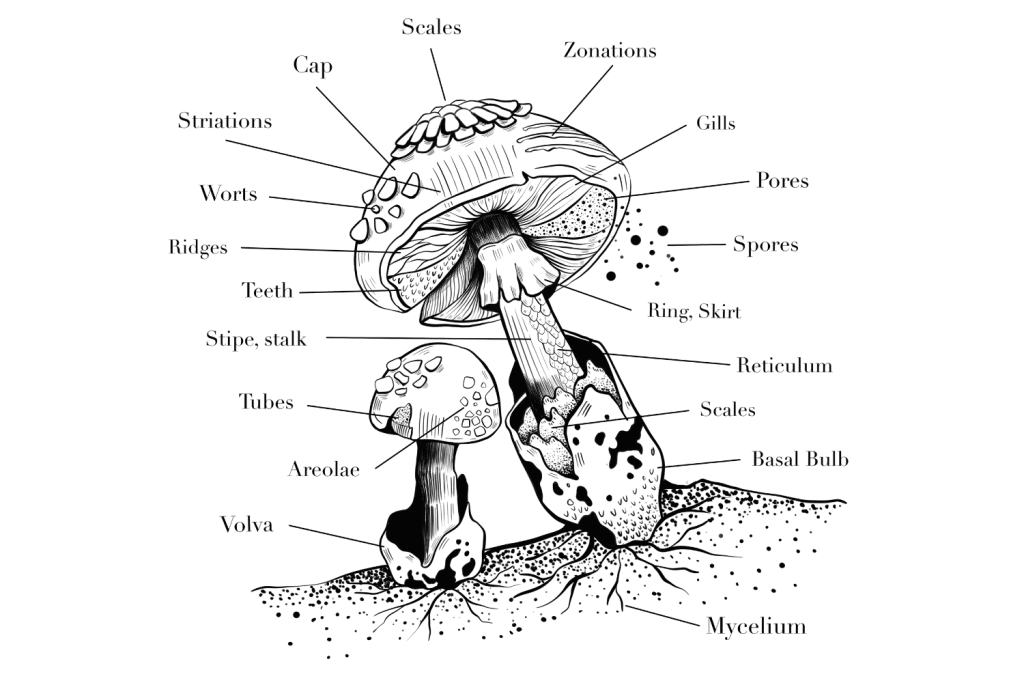
1. Mushroom Caps
The caps of Psilocybe caerulescens range from 3 to 10 cm (1.2 to 4 inches) in diameter. Young mushrooms can be campanulate (bell-shaped), becoming more convex (outwardly rounded) as they mature. The margins are inwardly curved, and the caps rarely flatten out, even once spores are dropped.
They are hygroscopic — meaning they absorb moisture from the air — so they can range in color from yellow-brown to red-brown and have a silver sheen when dry. They quickly develop blue bruises when touched. It’s common to find specimens with blue and black blemishes across the caps where they’ve been disturbed by environmental factors.
When wet, the cap margins are translucent, with stripes apparent from the gill attachment underneath. They have a gelatinous pellicle that can be noted when a wet cap is gently split. Cap shape and color can vary greatly in this species — you’ll often find a diverse array of different-looking mushrooms in a single cluster.
Related: Mushroom Anatomy 101
2. Gills
The gills of Psilocybe caerulescens are closely packed. They can be adnate (attached to the stipe) or sinuate (smoothly notched before the attachment to the stipe).
They are whitish-gray on young mushrooms but gradually darken and become dark gray/purple as the mushrooms age.
3. Stipe (Stem)
The stipe of Psilocybe caerulescens — from the basal bulb (bulbous base at the ground) to the underside of the cap — is 5 to 14 cm (2 to 5.5 inches) in length. They are between 8 and 10 millimeters thick with a slightly enlarged base and are somewhat wavy, hollow, and pruinose (covered with a fine white powdery substance).
The stipes appear mostly white because of the pruinose layer. When this is removed, the “true” reddish-brown color of the stipe can be seen. When damaged, the stems turn blue. The mushrooms have a well-developed veil when young, but an annulus (a remnant ring around the stipe from the veil) is not present on mature mushrooms.
4. Spores
Psilocybe caerulescens spores are hexagonal to subrhomboid when viewed from the front and ellipsoid when viewed from the side and are typically dark purple to purple-brown. The exact pigmentation can vary from specimen to specimen, but they generally fall within this range.
The length of the spores is approximately 6.7 to 8 µm (micrometers) but can be as small as 5.6 and as large as 9 µm. The width is 3.8 to 6.4 µm, but some examples can be as small as 4 µm or as large as 7.2 µm.
The basidium (the spore-bearing structures) typically produces four average-sized spores but occasionally produces two larger spores.
Psilocybe caerulescens Look-Alikes
Psilocybe caerulescens has several look-alikes — other mushroom species that share similarities. Many of these species are toxic, and some are lethal if ingested in large quantities.
Not only should you be able to identify P. caerulescens mushrooms, but you should also be able to identify its look-alikes. This will ensure you never mistake one of these species for a Landslide Mushroom. This is good practice with any mushroom species you wish to collect from the wild.
Here are a few common look-alike species that grow in a similar habitat to P. caerulescens:
1. Psilocybe ovoideocystidiata
Psilocybe ovoideocystidiata is another psychedelic mushroom species in the genus Psilocybe. It contains psilocybin and psilocin, but the effects may differ slightly from Psilocybe caerulescens. This species is not highly toxic.
Psilocybe ovoideocystidiata shares a similar appearance with Psilocybe caerulescens, with a reddish-brown cap, gelatinous pellicle, and white to tan-colored stipes. Both species also stain blue when damaged. They also share a similar habitat — favoring woody debris, mulch, and woodchips.
It can be difficult for the amateur forager to distinguish these two species. Luckily, they’re both edible psychoactive species from the same genus.
2. Panaeolus cinctulus
Panaeolus cinctulus — known commonly as the banded mottlegill — is a mildly psychoactive mushroom species that shares some similarities with Psilocybe caerulescens. The mushrooms have conical or bell-shaped caps that feature a banded pattern.
They’re slightly smaller than P. caerulescens mushrooms, but with similar coloration, you can see why some amateur foragers may mistake it for a Psilocybe species.
Although these mushrooms have been listed as poisonous for many years and have been blamed for several mushroom poisonings, they’re actually psychedelic. These shrooms produce low levels of psilocybin and psilocin. However, they do seem more likely to cause gastric discomfort compared to other psychedelic species.
3. Gymnopilus junonius
Gymnopilus junonius — known commonly as the Spectacular Rustgill or the Laughing Jim — is a wood-loving species that can be found growing in similar habitats to Psilocybe caerulescens. This species has rust-colored gills, tan-brown caps, and tan stems.
The amateur forager may mistake Gymnopilus junonius for a species of Psilocybe such as P. caerulescens. However, the stems are much thicker, and the cap is broader.
This species is considered toxic and can cause stomach upset if ingested. Scientists have discovered several toxins in the flesh of these mushrooms and have even found low levels of psilocybin and psilocin.
4. Conocybe spp.
Some species of Conocybe mushrooms, especially Conocybe siligineoides, have a similar appearance and may be found in similar habitats to Psilocybe caerulescens. These species share physical features such as brown caps and light-colored stems, but they can be distinguished through gill color, spore color, and physical traits.
Some species of Conocybe contain amatoxins and can prove fatal if ingested in large enough quantities.
5. Galerina marginata
Galerina marginata is commonly known as the funeral bell — for good reason, too. This species is highly toxic and can prove fatal if consumed in large enough quantities.
This species resembles Psilocybe caerulescens with its tan-brown cap, creamy-white stems, and similar size. It also shares a similar habit — growing on wood, woodchips, or near-rotting organic matter.
Galerina marginata mushrooms are a slightly different shade from Psilocybe caerulescens mushrooms. Their caps also flatten out when mature. They do not strain blue like Psilocybe species and have lighter, tan-colored gills.
Can You Grow Psilocybe caerulescens At Home?
Psilocybe caerulescens can be cultivated at home using a few simple techniques.
This species isn’t as easy to grow as Psilocybe cubensis. It’s slightly more susceptible to contamination, and you need to give them a stable temperature and humidity to produce successful results. However, you can use similar methods to grow P. caerulescens, and anyone with some experience should be able to grow these mushrooms.
You can buy spore samples through online spore vendors that ship to Canada, the United States, the United Kingdom, and most of Europe. They’re available as prints, swabs, vials, and spore syringes. I recommend purchasing spore-filled syringes if you wish to cultivate the spores — this format provides the easiest way to inoculate a substrate without introducing contamination.
You can purchase Psilocybe caerulescens spores from:
Related: Magic Mushroom Spore Vendor List 2024
It’s important to note that although magic mushroom spores are legal to buy in most countries, cultivating them is usually illegal (depending on where you live).
Make sure to check the laws in your region before cultivating Psilocybe caerulescens. If you decide to grow any psilocybin-containing fungi in a restricted country, you do so at your own risk.
How to Cultivate Psilocybe caerulescens Mushrooms
The easiest way to cultivate Psilocybe caerulescens is to utilize a technique known as “PF Tek” — Psilocybe Fanaticus Technique. This cultivation technique is easy to perform and requires very little equipment, time, and money.
If you decide to grow this species, you’ll need to keep the environment as stable as possible during incubation and fruiting (more on this later).
If you want to learn more about the PF Tek cultivation method, read through How to Grow Magic Mushrooms: The Easy Way.
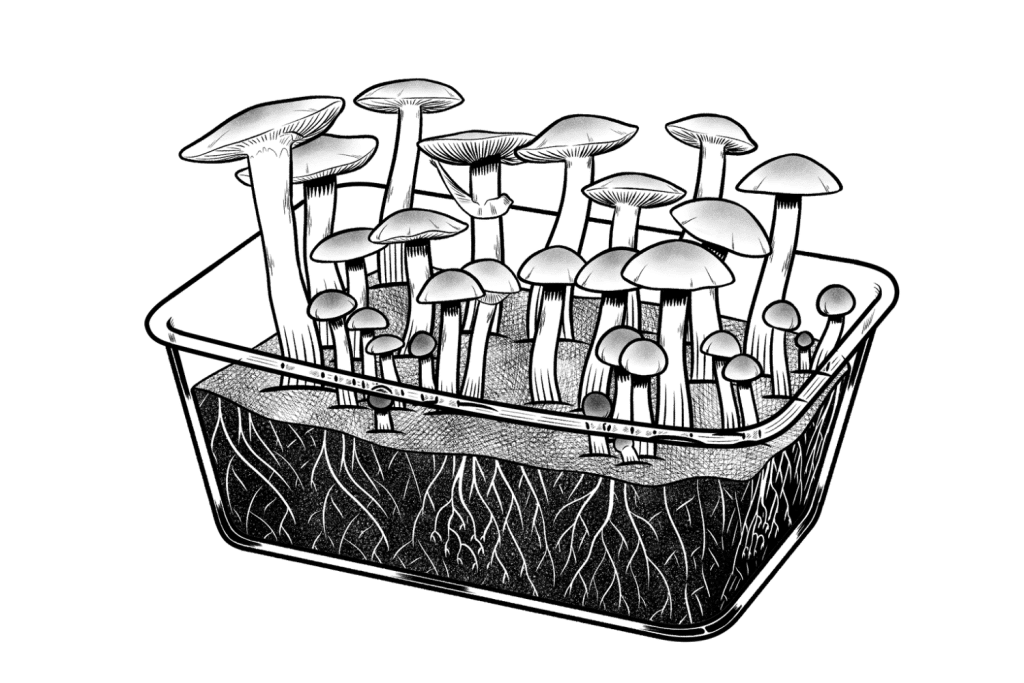
For now, here’s a quick rundown of the method and how you can adjust it for Psilocybe caerulescens:
Step 1: Preparing the Substrate
The first stage of the cultivation process requires you to prepare a growing medium so it’s sterile enough to inoculate with spores. The best results from Psilocybe caerulescens come on rye grain or straw, but you can also have success with BRF Cakes — a mixture of brown rice flour, vermiculite, and water.
Fill a series of glass mason jars with the chosen substrate before sealing the tops with foil. Place the lids upside-down on top of the foil. Then, “cook” the jars in a pressure cooker for 30 minutes before turning off the heat and allowing them to cool slowly inside. This process sterilizes the jars and substrate, preparing them for the next step.
Step 2: Inoculating the Growing Substrate
The second step requires the utmost care and attention. During inoculation, every piece of equipment and the surrounding area should be as sterile as possible. Do this by cleaning everything with isopropyl alcohol and sealing the room from the rest of the house.
A sterile spore syringe is the easiest way to inoculate the jars. Heat the needle with a flame and allow it to cool, then inject 2 to 4 CCs of the liquid through the foil into the substrate. Quickly seal the jar by screwing the lid on tight and resealing the top with foil.
Step 3: Incubating the Spores
Once inoculated, leave the jars to incubate for two to four weeks. Make a simple incubator from a couple of plastic containers and an aquarium heater (see here). Place the jars inside and make sure the incubator is set to a stable temperature of around 28 ºC (82 ºF).
The jars will be ready for the next step when the substrate is entirely white with mycelium.
Step 4: Fruiting the Mycelium
Once the mycelium has covered the entirety of the substrate within the jars, they are ready for fruiting.
This step requires a few simple pieces of equipment to make a “fruiting chamber” — a simple ventilated box that provides the correct temperature and humidity for Psilocybe caerulescens mushroom growth.
If possible, remove the resulting mycelium cakes from the jars and place them inside the fruiting chamber. If the cakes don’t come out, it’s not the end of the world — mushrooms will grow from the opening in the jar.
A lower temperature is needed during the fruiting phase — between 10 – 20 ºC (50 – 68ºF). It’s important to keep the temperature as stable as possible during this phase to produce the best results from Psilocybe caerulescens.
Keep the humidity around 80% by regularly misting the growing environment with a spray bottle filled with distilled water.
After a few days, the first small mushrooms will appear. Once mature, you can harvest and use or store them. Harvesting the mushrooms before they drop their spores will ensure that the colonies continue to fruit for as long as possible.
The mycelium cakes will produce mushrooms in flushes. The mushrooms will mature at different rates, meaning you’ll have to keep an eye on the fruiting chamber and harvest little and often. Eventually, the cakes will succumb to mold growth and cease producing mushrooms.
How to Prepare & Store Psilocybe caerulescens Mushrooms
Once you’ve grown or harvested Psilocybe caerulescens mushrooms from the wild, you can store them in the fridge for four or five days before they go bad. Cultivated mushrooms will last slightly longer.
If you want to store Psilocybe caerulescens mushrooms long-term, they’ll need to be preserved. The easiest way to do this is through drying, which will help them last for years if stored correctly.
Drying magic mushrooms is simple. Once you’ve harvested them, lay the mushrooms out on a sheet of grease-proof paper in a cool, well-ventilated area. It will take a few days for the mushrooms to dry completely. Placing a fan and/or dehumidifier next to them will speed up the process.
Using a food dehydrator is a much more efficient way to dry magic mushrooms —they should be dry within 24 hours. Set it at the lowest temperature, and make sure the mushrooms are spread evenly on the trays without touching each other.
You can tell when the mushrooms are completely dry by snapping the stems and caps. They should audibly “crack” when snapped and shouldn’t feel bendy.
Once completely dry, store the mushrooms in glass mason jars with a pouch or two of food-safe silica gel. This will remove any remaining moisture from the mushrooms, giving them a long shelf life. Place the jars in a cool, dark place.
Read more: The Art and Science of Drying Magic Mushrooms: Your Step-by-Step Guide
How Can Psilocybe caerulescens be Consumed?
Psilocybe caerulescens mushrooms can be prepared and consumed in several different ways. It can be as simple as chowing down on a dose of raw mushrooms or as complex as making psilocybin gummies or chocolates.
Here are a few popular methods of consumption for Psilocybe caerulescens mushrooms:
1. Eating the Mushrooms Whole
The easiest way to consume Psilocybe caerulescens is to eat the mushrooms whole — either dry or fresh.
A dose can be weighed (see dosage calculator above) before chewing and swallowing with water. This isn’t a particularly pleasant way to consume magic mushrooms, but it works.
You can improve the onset time and bioavailability of the psilocybin by using Lemon Tek. By soaking the mushrooms in lemon juice for 20 to 30 minutes before consumption, the cell walls of the mushrooms will break down slightly. This puts less strain on the digestive system — leading to less gastric discomfort and a faster onset of effects.
2. Making Magic Mushroom Tea
Making magic mushroom tea is a great way to consume Psilocybe caerulescens shrooms. By making tea, the organic matter is eliminated — leaving a psilocybin-infused brew that’s fast-acting and potent.
Making shroom tea is simple. You can find out how to make it in this article: How to Make Shroom Tea: Step-by-Step Guide.
3. Making Microdose Capsules
If you plan on using Psilocybe caerulescens for microdosing, you may be interested in making shroom capsules.
Capsules provide an easy, convenient, and tasteless way to consume psilocybin microdoses. Making them is as simple as grinding dried mushrooms into a powder, weighing out microdoses, and filling up empty pill capsules.
4. Making Psilocybin Edibles
If you don’t like the taste of magic mushrooms (let’s be honest, no one really does), making edibles is the way to go.
- Use this recipe to make psilocybin gummies from Psilocybe caerulescens.
- Use this recipe to make psilocybin chocolate bars from P. caerulescens with a spare hour and a few simple ingredients.
You can make a range of other tasty treats from Psilocybe caerulescens shrooms.
Check out our article: Trippy Cuisine: Learn How to Cook With Magic Mushrooms.
Are Psilocybe caerulescens Mushrooms Legal?
Psilocybe caerulescens contains psilocybin — a banned substance in most countries. Although these shrooms grow across Mexico and the Southern United States, they’re not necessarily legal to pick.
If you get caught possessing Psilocybe caerulescens or any other psilocybin-containing fungi in the United States, Australia, the United Kingdom, and most of Europe, you could face some serious charges. Some countries will even put you in prison for possessing “large amounts” of these shrooms.
That being said, there are some exceptions, and the laws surrounding magic mushrooms are beginning to relax in some countries.
Canada
Canada is an unusual beast in terms of magic mushrooms and psychedelic laws.
Psilocybin remains a restricted substance in Canada — the production, sale, and possession of psilocybin mushrooms is illegal. However, the laws surrounding magic mushrooms are rarely enforced. It’s also possible to get “an exemption” from Health Canada if the individual has a “serious or life-threatening condition that may be treatable with psilocybin.”
There are several “magic mushroom shops” appearing across Canada. Buying shrooms is as easy as heading into a local store or ordering online through a magic mushroom vendor. Police rarely raid these stores. Law enforcement appears to prioritize more harmful crimes over the sale, consumption, and cultivation of mushrooms containing psilocybin.
It’s likely that magic mushrooms and potentially other psychedelics such as LSD and mescaline will follow a similar route to cannabis in Canada. Eventually, these shroom stores will become legal and regulated by the government.
The United States
In the United States, psilocybin — and thus magic mushrooms — are illegal under federal law. However, a handful of US States (or municipalities within them) have legalized or decriminalized psilocybin.
The laws surrounding psilocybin-containing mushrooms have been altered in these seven US states (or municipalities within the state) so far:
Some states on the list above have decriminalized magic mushrooms, others have legalized them completely, and some have made exceptions to psilocybin consumption for certain medical reasons.
Some states — specifically California, Colorado, Massachusetts, and Michigan — have not legalized the substance state-wide. Instead, certain municipalities within the states have altered their laws.
Europe
Magic mushrooms remain illegal in most of Europe. However, there are a few exceptions.
In the Netherlands, magic mushrooms used to be legal to buy and consume — “Smart Shops” sold the psychedelic fungi for years. However, they’ve since been made illegal. There is a loophole, though — psilocybin-containing sclerotia (truffle-like growths) are legal and can still be obtained from Smart Shops across the country under the name “Magic Truffles.”
In Portugal, all drugs have been decriminalized. Now, this doesn’t mean that all drugs are legal, but they can be owned and consumed freely without repercussions from law enforcement. The sale of magic mushrooms is still restricted, so they can be hard to come by. However, a few illegal shops are popping up in cities across the country.
In Austria, psilocybin-containing fungi are legal to possess and cultivate. However, they’re illegal when they’re obtained or grown with the intent to use them as a “drug” — this one is a bit of a strange loophole.
Frequently Asked Questions About Psilocybe caerulescens
We get a lot of questions about shrooms, so here are the answers to a few you might be asking.
1. What Magic Mushroom Species Are Good for Microdosing?
Psilocybe caerulescens is an excellent magic mushroom for microdosing because its weak potency makes it easy to divide into sub-perceptual doses. However, it’s not the only psilocybin-producing mushroom species suited for microdosing.
Any magic mushroom can be used for microdosing, even species as potent as Psilocybe azurescens. It’s more difficult for the average person to divide such potent shrooms into non-psychoactive doses.
The criteria for a good microdose mushroom are as follows:
- Weak to average potency
- Easy to obtain
- Relatively stable tryptamine levels
Several species fit the criteria above. Here are a few species to look at if you want to source shrooms with the intent of microdosing psilocybin:
2. What’s the Easiest Magic Mushroom Species to Grow?
The easiest magic mushroom species to grow is Psilocybe cubensis. This species has been cultivated since the 1960s. It’s incredibly resistant to contamination and can grow in an unoptimized environment. These features make it perfect for indoor mushroom cultivation.
Psilocybe cubensis is made up of several different strains. These strains exhibit alterations in appearance, growth characteristics, and tryptamine contents. Some strains are easier to grow than others, but 90% can be grown by beginners.
Here are some of the easiest Psilocybe cubensis strains to cultivate:
- The Golden Teacher Strain
- The Koh Samui Strain
- The Cambodian Strain
- The Allen Strain
- The Orissa India Strain
- The A+ Strain
- The F+ Strain
- The Lipa Yai Strain
3. What’s the Difference Between “Strain” and “Species?”
You may have heard the term “strain” thrown around a lot if you’ve been looking at magic mushrooms. It’s easy to assume that a strain is the same as a species, but that’s not correct.
A species is a genetically unique subset under a single genus. For example, Psilocybe caerulescens and Psilocybe cubensis are both species in the Psilocybe genus.
A strain is a genetic variant within a single species. Strains belong to an individual species but exhibit slightly different traits. For example, Psilocybe cubensis (a species of the genus Psilocybe) is made up of hundreds of strains, such as Penis Envy, B+, and Golden Teacher. These strains exhibit differences in growth characteristics and tryptamine levels but belong to the same species.
4. How Many Species of Psilocybin-Producing Mushrooms Are There?
There are over 180 different species of psilocybin-producing mushroom species. Many of these species belong to the genus Psilocybe, but they also exist within different genera, such as Panaeolus, Gymnopilus, Conocybe, and Inocybe.
Here are some of the most common psilocybin-producing mushroom species:
- Psilocybe azurescens
- Psilocybe baeocystis
- Psilocybe cubensis
- Psilocybe cyanescens
- Psilocybe mexicana
- Psilocybe semilanceata
- Psilocybe weilii
- Panaeolus cyanescens
- Panaeolus cinctulus
Subscribe For More 🍄
References
- Gotvaldová, K., Borovička, J., Hájková, K., Cihlářová, P., Rockefeller, A., & Kuchař, M. (2022). Extensive collection of psychotropic mushrooms with determination of their tryptamine alkaloids. International Journal of Molecular Sciences, 23(22), 14068.
- Beug, M. W., & Bigwood, J. (1982). Psilocybin and psilocin levels in twenty species from seven genera of wild mushrooms in the Pacific Northwest, USA. Journal of ethnopharmacology, 5(3), 271-285.
- Cavanna, F., Muller, S., de la Fuente, L. A., Zamberlan, F., Palmucci, M., Janeckova, L., … & Tagliazucchi, E. (2022). Microdosing with psilocybin mushrooms: a double-blind placebo-controlled study. Translational Psychiatry, 12(1), 307.

